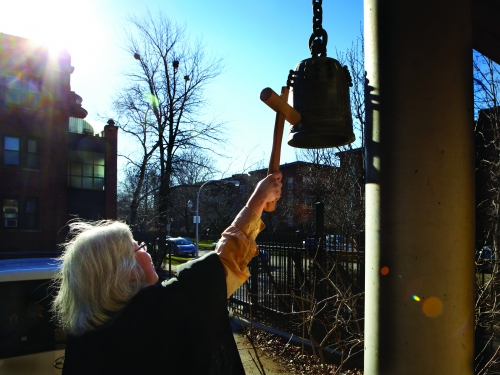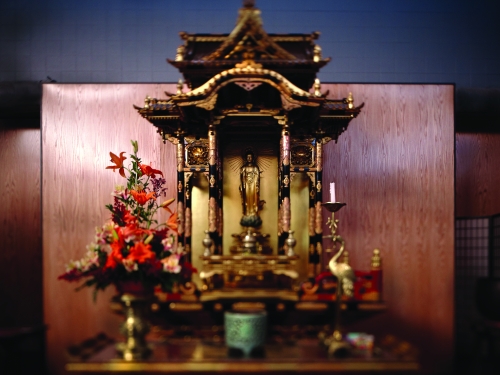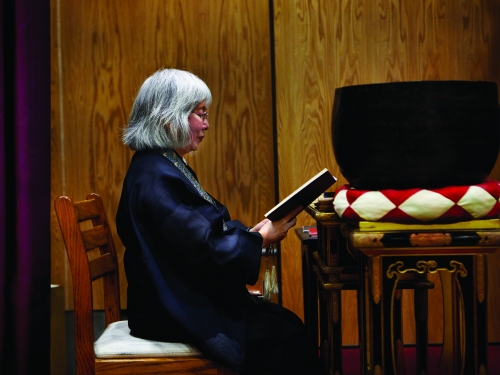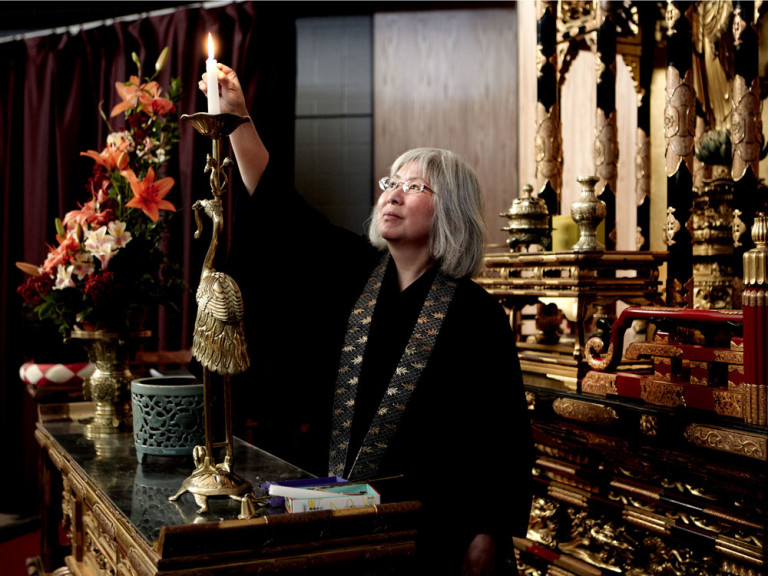Reverend Patti Nakai, the associate minister at the Buddhist Temple of Chicago, grew up as a Presbyterian. Born in the Lakeview area of Chicago, to a Buddhist father and a Christian mother, she attended a church with a congregation that, like the neighborhood itself, was heavily Japanese-American. A third-generation Japanese-American herself, Reverend Patti began delving into the Buddhist side of her heritage while at the University of Minnesota, where she earned a degree in international economics and Japanese history and culture.
After graduation, Nakai returned to her hometown to find that a staunchly conservative minister had taken over her childhood church. This change, coupled with a lingering heartbreak from college, led her to join her father’s old congregation at the Buddhist Temple of Chicago.
Encouraged by one of her teachers there, Reverend Patti went to Japan to study Shin Buddhism at Otani University in Kyoto. She received a master’s degree in Shin Buddhist studies as well as full ordination from Higashi Honganji, the mother temple in Kyoto of the Otani-ha subdenomination of Shin Buddhism, known for its looser, nonliteral interpretations of Shin texts and doctrines. After a stint as a nonresident minister at a temple in Los Angeles, she returned in 1995 to the Buddhist Temple of Chicago.
Despite years of formal study, Reverend Patti doesn’t take herself too seriously. Her nickname from her time in Japan is Fuketsu, which means “not pure,” and her teachings are often couched in colloquialisms. She recalls with fondness a series of lectures that she named “The Major Dudes in Buddhism,” inspired by the Steely Dan song “Any Major Dude Will Tell You.” She runs the blog “Taste of Chicago Buddhism,” where she shares her musings on the Buddhist news from her city and the temple that she has long called her home.
—Emma Varvaloucas, Associate Editor
You were brought up as a Presbyterian. How did you become a Shin minister?Oh, that’s a story that I tell often. My parents were like a lot of Japanese American couples in the time after World War II, in that one was Buddhist and the other was Christian. And as in a lot of families back then, the mother decided the religion of the kids. My mother was brought up in the Baptist tradition, but since there weren’t any nearby Baptist churches in our Chicago neighborhood, she picked a Presbyterian church that was just a couple of blocks away.
When I was in college at the University of Minnesota during the 1970s, there was this big push to get back to your roots; a lot of other ethnic groups were inspired by the Black Power activists who took pride in their African heritage. I started studying Asian history and culture, and of course Buddhism was a very big part of that. To practice my Japanese, I would write letters to my grandfather in California, and when I wrote to him that I was starting to get interested in Buddhism, he went out of his way to send me a big package of books.
They were mostly Jodo Shinshu books, and I have to admit that at the beginning it was very daunting. The translations were written in that stiff-sounding English of nonnative speakers, and it was assumed that the people reading them were temple members who already had a background in Shin Buddhism. But for me, just reading it straight, without context—it didn’t make much sense. Despite that, Buddhism was still attractive, and when I came back to Chicago after college with a broken heart—the love of my life was going to marry another woman—I thought I’d make a fresh start. My old Presbyterian church had gotten very conservative, so I settled at the Buddhist Temple of Chicago, where my father was involved before he got married. From the beginning I felt very welcomed there, but sometime along the way, one minister said something at a service that really spoke to my heart. Even to this day I can’t tell you what it was he said, but from that time on I felt that the temple was my home.
When did Jodo Shinshu start making sense to you? At the temple I got involved first with the meditation group, because that’s what made sense to me. I thought that if Buddhism was about attaining peace, then meditation was the way to do that. I practiced for a while, and I thought that I was making progress in calming myself. But then the woman who had married the man I loved died of cancer, and that really threw my meditation into a wall. All the progress that I thought I had made toward inner peace was blown away. When I heard that this guy was going to visit Chicago and sit in our meditation group, I decided: That’s one session I’m not going to be able to meditate through.
The Sunday that he was scheduled to come on was Ho-on-ko, the memorial for Shinran Shonin [the founder of the Shin school of Pure Land Buddhism, also known as Jodo Shinshu]. As a dharma school teacher, I had to read up on Shinran in order to teach the children something about Ho-on-ko. When I read in the dharma school teachers’ handbook about Shinran’s struggle—he was a monk, and he was trying to overcome his passions but was hitting a wall—I felt that that was exactly where I was at that time. The Ho-on-ko lesson ended by saying that Shinran finally found the solution to his problems when he encountered thenembutsu teaching [Shin Buddhism’s central practice of chanting “Namu Amida Butsu”]. And what with that guy coming to Chicago to meditate and me feeling so emotional about his wife dying, I wanted badly to understand exactly what it was about the nembutsu that brought Shinran out of his state of anxiety.
That Sunday I couldn’t bring myself to attend the meditation session, but I had to be at the temple for the regular family service and to teach the dharma school class. When I arrived for the service I heard that he had left right after meditation because he wanted to attend service at the Midwest Buddhist Temple, the other Shin temple in Chicago. So though that day’s drama was avoided, the anxiety continued in my mind. I tried for months to understand the nembutsu, but I kept on hitting dead ends. I just never got a satisfactory explanation. I’d ask the ministers at the temple, “What is ‘Namu Amida Butsu’?” And they’d say, “Well, it’s Namu Amida Butsu.” Nobody was really explaining what it is, what it does! Here meditation didn’t work for me, and now this nembutsu thing wasn’t working for me, either. But right at the point when I was about to quit the temple, the minister who had spoken to my heart when I first joined, Reverend Gyoko Saito, came back to the temple as a guest speaker from Los Angeles, and he really brought the nembutsu alive for me. After he spoke, I told his wife that I wished Reverend Saito could stay in Chicago because I wanted him for a teacher (I was too chicken to approach Reverend Saito directly). She told me that there was already a good teacher at our temple—Dr. Nobuo Haneda, a recent Ph.D. graduate whom I hadn’t paid much attention to. I started attending his weekly study classes, where he brought in a lot of Zen while going over the Pure Land texts. And it finally started making sense.
Did you ever figure out what it was about the nembutsu that can take someone out of their anxiety, as it did for Shinran? The very first thing that I heard from Dr. Haneda in his class was that most religions are about grasping up, and he motioned his hand upward like his fingers were trying to grab something. People’s idea of religion is that you’re trying to grab something above you, but Buddhism looks at the hand. That’s how we work on our anxiety, by looking at ourselves and seeing our grasping nature. You have to recognize that, but you also have to recognize that there’s a way beyond that. To see it is to transcend it. If you don’t see it, you’re continually driven by it. The word nembutsu means to remember the way of the Buddha. And so the phrase “Namu Amida Butsu” tells us to examine our self and feel humbled—it’s admitting to yourself that you’re not so hot as you thought you were, but at the same time it’s realizing that you are part of this great, living, flowing life with all other beings. It’s an opening of the heart.
The nembutsu reminds me when I feel anxiety that it’s me that is the source of the anxiety; that my problems are mainly caused by my own ego striving. I have to be reminded that it’s not all about me, but that I’m still a unique part of the greater life that’s out there. So that’s why I tell people that saying the nembutsu is not a practice; I try to avoid talking of “Namu Amida Butsu” as something to “recite.” It’s not something you do for some result. It’s more about listening and receiving, of being reminded of the awareness of what life truly is. In a lot of Shin Buddhist writing it is referred to as “the calling”—the calling of the universe to us.
One of your favorite quotes is “Rather than answer your questions, the Buddha questions your answers.” How does that come into play in Buddhist practice?People come to Buddhism looking for answers, but Buddhism is not about giving you some easy formula. It’s all about you needing to question yourself. When you think you’ve got it, that’s when you especially need to question it—and if you don’t question it right away, you’ll run into situations that will make you question it, if you’re fortunate. Life is always throwing monkey wrenches into the machinery of your calculating mind.
In reading your blog, “Taste of Chicago Buddhism,” I felt there must be a lighthearted atmosphere at your temple, which is reflected in your own writing and teaching. For example, you reworked Amida’s 35th vow from theImmeasurable Life Sutra, which says that you have to be male to realize enlightenment. You redid it as “May I obtain the highest enlightenment only when women who hear my name realize how demeaning it is to be seen as a bimbo.” Right. That’s something that women are struggling with even now: what society says your image should be. And unfortunately, when you turn on the TV and watch movies, there’s still too much where the woman is shown as this very flighty, insubstantial person to deal with, but who looks very sexy and glamorous. Once you realize as a woman that you’re more than that, you vow that you’re not going to be that way.
How do you feel about the more traditional reading of the vow, which says that women must be reborn in a male body in order to reach enlightenment? One of the things that I tell people is that I have yet to see a good printed translation of the 35th vow. What the Chinese version conveys just doesn’t get translated into English very skillfully.  The term used in the Chinese is actually more like “image” than “body.” So my translation is that women will not be reborn in that image that males have, that they will instead be reborn in an image that’s not judged, or reborn as someone who is not judged by image. See, the vow is really written from a man’s point of view: “Once I realize women are more than bimbos, then in my mind I’ll never see them again like that”—meaning “They will not be borne in my mind that way. I will not conceive of them anymore in that way.” The translated versions I’ve seen take it from a male chauvinistic viewpoint, which make it sound like there’s something wrong about being a woman. It’s a problem that is found throughout the Buddhist texts, the idea that it is impossible to become a Buddha in a female body.
The term used in the Chinese is actually more like “image” than “body.” So my translation is that women will not be reborn in that image that males have, that they will instead be reborn in an image that’s not judged, or reborn as someone who is not judged by image. See, the vow is really written from a man’s point of view: “Once I realize women are more than bimbos, then in my mind I’ll never see them again like that”—meaning “They will not be borne in my mind that way. I will not conceive of them anymore in that way.” The translated versions I’ve seen take it from a male chauvinistic viewpoint, which make it sound like there’s something wrong about being a woman. It’s a problem that is found throughout the Buddhist texts, the idea that it is impossible to become a Buddha in a female body.
How do you see the current state of Shin Buddhism in the United States? What are some promising trends? A lot of temples are waking up to the fact that they’re not going to be a Japanese-American social club anymore. For example, one of the things I’m working on now for the 2013 International Association of Shin Buddhist Studies conference in Vancouver is a paper about how maybe the phrase “Namu Amida Butsu” is too Japanese-y. It has little meaning for those of us raised in the West—we have to find our own way of expressing the nembutsu. Shinran himself explored ways to translate the Sinicized Sanskrit syllables into words that made sense in the Japanese vernacular. So he wasn’t stuck on saying the particular syllables of “Namu Amida Butsu.”
 And what about some of thechallenges it is facing? Pure Land doesn’t get a whole lot of respect in the Buddhist community. There’s a lot of misunderstanding about what it is. Other Buddhists think that we’re a bunch of lazy-asses because we don’t do the fancy practices and rituals that they do. But in reality, for the people who get into Pure Land, it is a very challenging path. It’s a path that challenges you all the time; it’s psychologically rigorous.
And what about some of thechallenges it is facing? Pure Land doesn’t get a whole lot of respect in the Buddhist community. There’s a lot of misunderstanding about what it is. Other Buddhists think that we’re a bunch of lazy-asses because we don’t do the fancy practices and rituals that they do. But in reality, for the people who get into Pure Land, it is a very challenging path. It’s a path that challenges you all the time; it’s psychologically rigorous.
Part of the misunderstanding is due to the poor translations that we have. And part of it is just that we need to get people more familiar with our tradition so that they don’t dismiss it out of hand. Pure Land is not for everybody, but for some people it is exactly what they need.
What do you feel is most commonly misunderstood about Pure Land Buddhism? They think we’re praying to some god called Amida who is going to save us from hell or something. When people come to our temple, we point to the statue of Amida and say, “That’s a symbol. Amida is a symbol of infinite wisdom and compassion.” The name Amida, which can be spelled out in Sanskrit as Amitabha (“unbounded light”) or Amitayus (“unlimited life”), is just a symbol for light, meaning wisdom, and life, meaning compassion. So that’s always the challenge when you talk about Amida: what are we talking about in the first place? If you just throw the word out, people are likely to think, “They must be talking about some divine being with magic supernatural powers or something.” People put all the Pure Land groups in a box as believing in a divine savior. There are some Pure Land groups whose lay members take it very literally, but most of the people who really study the texts know that you’re not meant to take Amida as a literal figure.
Do you think there is a lot of misunderstanding about what the Pure Land is as well? Yeah. I always tell people that “Pure Land” is a mistranslation to begin with. In Sanskrit, sukhavati refers to the land of sukha, which is having no conflict and going with the flow. It’s the opposite of dukha, which is conflict—you’re in conflict with your mind and in conflict with the world, and it causes this sense of friction, of irritation and annoyance. Butsukha means that you’re in the flow, that you’re into the impermanence of life in a very creative way. You’re not stuck thinking that things have to be this way or that way; you’re very flexible.
That sense of flow got translated into Chinese characters that mean “to clean out” or “to purify.” In ancient China, everyone went down to the river to clean their clothes—you just dunked them in the river and let the river clean them out. So the flowing of the river, that sense of flow that gets your laundry clean, that gets things pure, got translated into English as “Pure Land.” It’s not such a bad idea, but people get stuck on the word “pure” as meaning something static, whereas the Pure Land actually refers to a river that is always flowing briskly with clear water. Even the word “land” is too solid for what we are describing. “Realm” is kind of better, if you take it as indicating the way you see the world and not as some geographical land. “To be born in the Pure Land” means to awaken to that realm of going with the flow.
Speaking of Pure Land, you have a quote on your blog that reads, “In Jodo Shinshu we learn that the idealistic concept of purity that we cling to is as much of a lie as believing we can be forever young and able-bodied.” That’s what I’m saying—people have such ideas of what purity means. The Pure Land teachers keep reiterating the point that we human beings cannot achieve consistent, constant, and complete perfection in any aspects of our virtues. We think that there’s a pure state free from defilements that we can attain and keep hanging on to, but it’s a delusion.
And that relates to another theme you’ve spoken about: the idea of getting in touch with your bonbu nature. Pure Land emphasizes that to come down to your natural self is to be bonbu, to be just a foolish, ordinary person, to own up to one’s own three poisons of greed, anger, and stupidity. Owning up to that bursts our bubble of thinking that you can completely overcome those poisons in a permanent way. Thinking that is just the ego taking over, and Pure Land teaching, just like any Buddhist teaching, is trying to get us past the ego self. When people ask me to sum up the Buddhist teachings, that’s what I say: “Get real, people.”
Thank you for subscribing to Tricycle! As a nonprofit, we depend on readers like you to keep Buddhist teachings and practices widely available.
